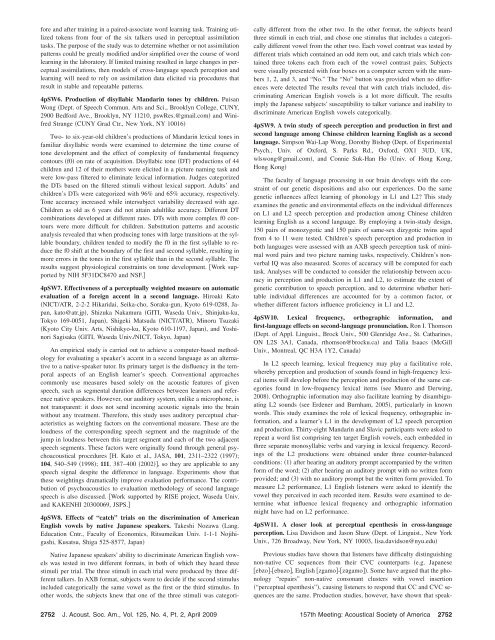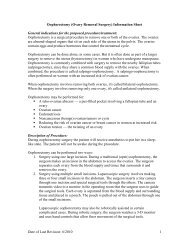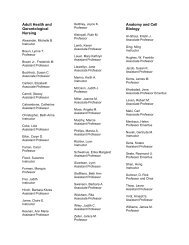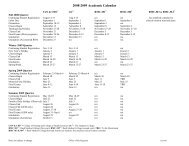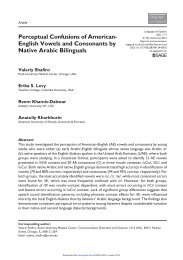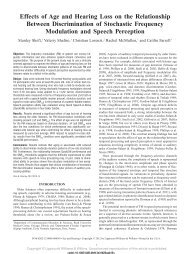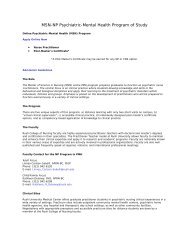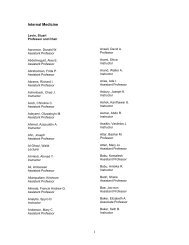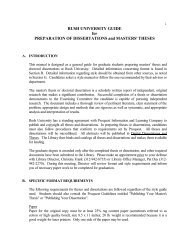Perceptual confusions of American English vowels ... - Rush University
Perceptual confusions of American English vowels ... - Rush University
Perceptual confusions of American English vowels ... - Rush University
You also want an ePaper? Increase the reach of your titles
YUMPU automatically turns print PDFs into web optimized ePapers that Google loves.
fore and after training in a paired-associate word learning task. Training utilized<br />
tokens from four <strong>of</strong> the six talkers used in perceptual assimilation<br />
tasks. The purpose <strong>of</strong> the study was to determine whether or not assimilation<br />
patterns could be greatly modified and/or simplified over the course <strong>of</strong> word<br />
learning in the laboratory. If limited training resulted in large changes in perceptual<br />
assimilations, then models <strong>of</strong> cross-language speech perception and<br />
learning will need to rely on assimilation data elicited via procedures that<br />
result in stable and repeatable patterns.<br />
4pSW6. Production <strong>of</strong> disyllabic Mandarin tones by children. Puisan<br />
Wong Dept. <strong>of</strong> Speech Commun. Arts and Sci., Brooklyn College, CUNY,<br />
2900 Bedford Ave., Brooklyn, NY 11210, pswRes.@gmail.com and Winifred<br />
Strange CUNY Grad Ctr., New York, NY 10016<br />
Two- to six-year-old children’s productions <strong>of</strong> Mandarin lexical tones in<br />
familiar disyllabic words were examined to determine the time course <strong>of</strong><br />
tone development and the effect <strong>of</strong> complexity <strong>of</strong> fundamental frequency<br />
contours f0 on rate <strong>of</strong> acquisition. Disyllabic tone DT productions <strong>of</strong> 44<br />
children and 12 <strong>of</strong> their mothers were elicited in a picture naming task and<br />
were low-pass filtered to eliminate lexical information. Judges categorized<br />
the DTs based on the filtered stimuli without lexical support. Adults’ and<br />
children’s DTs were categorized with 96% and 65% accuracy, respectively.<br />
Tone accuracy increased while intersubject variability decreased with age.<br />
Children as old as 6 years did not attain adultlike accuracy. Different DT<br />
combinations developed at different rates. DTs with more complex f0 contours<br />
were more difficult for children. Substitution patterns and acoustic<br />
analysis revealed that when producing tones with large transitions at the syllable<br />
boundary, children tended to modify the f0 in the first syllable to reduce<br />
the f0 shift at the boundary <strong>of</strong> the first and second syllable, resulting in<br />
more errors in the tones in the first syllable than in the second syllable. The<br />
results suggest physiological constraints on tone development. Work supported<br />
by NIH 5F31DC8470 and NSF.<br />
4pSW7. Effectiveness <strong>of</strong> a perceptually weighted measure on automatic<br />
evaluation <strong>of</strong> a foreign accent in a second language. Hiroaki Kato<br />
NICT/ATR, 2-2-2 Hikaridai, Seika-cho, Soraku-gun, Kyoto 619-0288, Japan,<br />
kato@atr.jp, Shizuka Nakamura GITI, Waseda Univ., Shinjuku-ku,<br />
Tokyo 169-0051, Japan, Shigeki Matsuda NICT/ATR, Minoru Tsuzaki<br />
Kyoto City Univ. Arts, Nishikyo-ku, Kyoto 610-1197, Japan, and Yoshinori<br />
Sagisaka GITI, Waseda Univ./NICT, Tokyo, Japan<br />
An empirical study is carried out to achieve a computer-based methodology<br />
for evaluating a speaker’s accent in a second language as an alternative<br />
to a native-speaker tutor. Its primary target is the disfluency in the temporal<br />
aspects <strong>of</strong> an <strong>English</strong> learner’s speech. Conventional approaches<br />
commonly use measures based solely on the acoustic features <strong>of</strong> given<br />
speech, such as segmental duration differences between learners and reference<br />
native speakers. However, our auditory system, unlike a microphone, is<br />
not transparent: it does not send incoming acoustic signals into the brain<br />
without any treatment. Therefore, this study uses auditory perceptual characteristics<br />
as weighting factors on the conventional measure. These are the<br />
loudness <strong>of</strong> the corresponding speech segment and the magnitude <strong>of</strong> the<br />
jump in loudness between this target segment and each <strong>of</strong> the two adjacent<br />
speech segments. These factors were originally found through general psychoacoustical<br />
procedures H. Kato et al., JASA, 101, 2311–2322 1997;<br />
104, 540–549 1998; 111, 387–400 2002, so they are applicable to any<br />
speech signal despite the difference in language. Experiments show that<br />
these weightings dramatically improve evaluation performance. The contribution<br />
<strong>of</strong> psychoacoustics to evaluation methodology <strong>of</strong> second language<br />
speech is also discussed. Work supported by RISE project, Waseda Univ.<br />
and KAKENHI 20300069, JSPS.<br />
4pSW8. Effects <strong>of</strong> “catch” trials on the discrimination <strong>of</strong> <strong>American</strong><br />
<strong>English</strong> <strong>vowels</strong> by native Japanese speakers. Takeshi Nozawa Lang.<br />
Education Cntr., Faculty <strong>of</strong> Economics, Ritsumeikan Univ. 1-1-1 Nojihigashi,<br />
Kusatsu, Shiga 525-8577, Japan<br />
Native Japanese speakers’ ability to discriminate <strong>American</strong> <strong>English</strong> <strong>vowels</strong><br />
was tested in two different formats, in both <strong>of</strong> which they heard three<br />
stimuli per trial. The three stimuli in each trial were produced by three different<br />
talkers. In AXB format, subjects were to decide if the second stimulus<br />
included categorically the same vowel as the first or the third stimulus. In<br />
other words, the subjects knew that one <strong>of</strong> the three stimuli was categorically<br />
different from the other two. In the other format, the subjects heard<br />
three stimuli in each trial, and chose one stimulus that includes a categorically<br />
different vowel from the other two. Each vowel contrast was tested by<br />
different trials which contained an odd item out, and catch trials which contained<br />
three tokens each from each <strong>of</strong> the vowel contrast pairs. Subjects<br />
were visually presented with four boxes on a computer screen with the numbers<br />
1, 2, and 3, and “No.” The “No” button was provided when no differences<br />
were detected The results reveal that with catch trials included, discriminating<br />
<strong>American</strong> <strong>English</strong> <strong>vowels</strong> is a lot more difficult. The results<br />
imply the Japanese subjects’ susceptibility to talker variance and inability to<br />
discriminate <strong>American</strong> <strong>English</strong> <strong>vowels</strong> categorically.<br />
4pSW9. A twin study <strong>of</strong> speech perception and production in first and<br />
second language among Chinese children learning <strong>English</strong> as a second<br />
language. Simpson Wai-Lap Wong, Dorothy Bishop Dept. <strong>of</strong> Experimental<br />
Psych., Univ. <strong>of</strong> Oxford, S. Parks Rd., Oxford, OX1 3UD, UK,<br />
wlswong@gmail.com, and Connie Suk-Han Ho Univ. <strong>of</strong> Hong Kong,<br />
Hong Kong<br />
The faculty <strong>of</strong> language processing in our brain develops with the constraint<br />
<strong>of</strong> our genetic dispositions and also our experiences. Do the same<br />
genetic influences affect learning <strong>of</strong> phonology in L1 and L2 This study<br />
examines the genetic and environmental effects on the individual differences<br />
on L1 and L2 speech perception and production among Chinese children<br />
learning <strong>English</strong> as a second language. By employing a twin-study design,<br />
150 pairs <strong>of</strong> monozygotic and 150 pairs <strong>of</strong> same-sex dizygotic twins aged<br />
from 4 to 11 were tested. Children’s speech perception and production in<br />
both languages were assessed with an AXB speech perception task <strong>of</strong> minimal<br />
word pairs and two picture naming tasks, respectively. Children’s nonverbal<br />
IQ was also measured. Scores <strong>of</strong> accuracy will be computed for each<br />
task. Analyses will be conducted to consider the relationship between accuracy<br />
in perception and production in L1 and L2, to estimate the extent <strong>of</strong><br />
genetic contribution to speech perception, and to determine whether heritable<br />
individual differences are accounted for by a common factor, or<br />
whether different factors influence pr<strong>of</strong>iciency in L1 and L2.<br />
4pSW10. Lexical frequency, orthographic information, and<br />
first-language effects on second-language pronunciation. Ron I. Thomson<br />
Dept. <strong>of</strong> Appl. Linguist., Brock Univ., 500 Glenridge Ave., St. Catharines,<br />
ON L2S 3A1, Canada, rthomson@brocku.ca and Talia Isaacs McGill<br />
Univ., Montreal, QC H3A 1Y2, Canada<br />
In L2 speech learning, lexical frequency may play a facilitative role,<br />
whereby perception and production <strong>of</strong> sounds found in high-frequency lexical<br />
items will develop before the perception and production <strong>of</strong> the same categories<br />
found in low-frequency lexical items see Munro and Derwing,<br />
2008. Orthographic information may also facilitate learning by disambiguating<br />
L2 sounds see Erdener and Burnham, 2005, particularly in known<br />
words. This study examines the role <strong>of</strong> lexical frequency, orthographic information,<br />
and a learner’s L1 in the development <strong>of</strong> L2 speech perception<br />
and production. Thirty-eight Mandarin and Slavic participants were asked to<br />
repeat a word list comprising ten target <strong>English</strong> <strong>vowels</strong>, each embedded in<br />
three separate monosyllabic verbs and varying in lexical frequency. Recordings<br />
<strong>of</strong> the L2 productions were obtained under three counter-balanced<br />
conditions: 1 after hearing an auditory prompt accompanied by the written<br />
form <strong>of</strong> the word; 2 after hearing an auditory prompt with no written form<br />
provided; and 3 with no auditory prompt but the written form provided. To<br />
measure L2 performance, L1 <strong>English</strong> listeners were asked to identify the<br />
vowel they perceived in each recorded item. Results were examined to determine<br />
what influence lexical frequency and orthographic information<br />
might have had on L2 performance.<br />
4pSW11. A closer look at perceptual epenthesis in cross-language<br />
perception. Lisa Davidson and Jason Shaw Dept. <strong>of</strong> Linguist., New York<br />
Univ., 726 Broadway, New York, NY 10003, lisa.davidson@nyu.edu<br />
Previous studies have shown that listeners have difficulty distinguishing<br />
non-native CC sequences from their CVC counterparts e.g. Japanese<br />
ebzo-ebuzo, <strong>English</strong> zgamo-z.gamo. Some have argued that the phonology<br />
“repairs” non-native consonant clusters with vowel insertion<br />
“perceptual epenthesis”, causing listeners to respond that CC and CVC sequences<br />
are the same. Production studies, however, have shown that speak-<br />
2752 J. Acoust. Soc. Am., Vol. 125, No. 4, Pt. 2, April 2009 157th Meeting: Acoustical Society <strong>of</strong> America 2752


